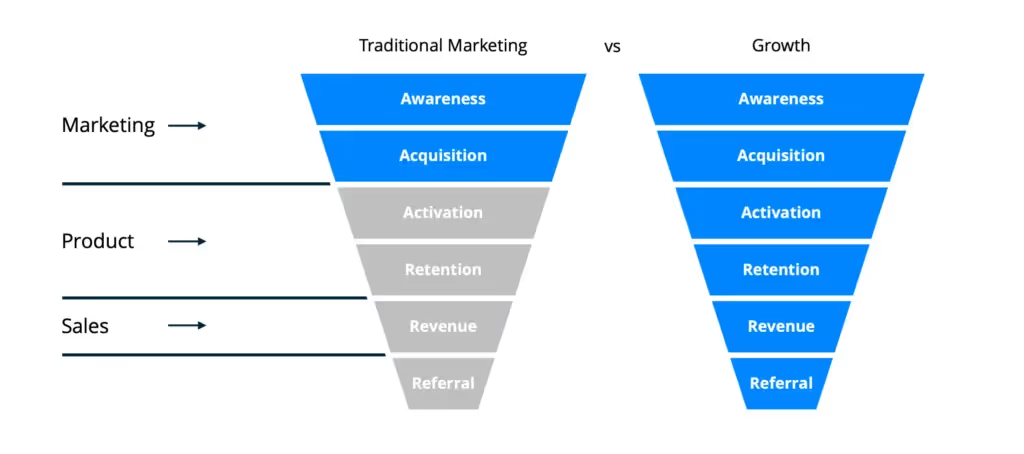B2B (Business-To-Business) and B2C (Business-To-Consumer) are two terms that often come up in the growth marketing world. You’re likely already familiar with these terms.
However, knowing the difference between B2B and B2C and knowing how marketing strategies are different for each is another matter.
Marketing to B2B audiences and marketing to B2C audiences require different approaches, and that’s what this article will delve into. You’ll learn how to build a marketing strategy that makes sense, whether your focus is on B2B or B2C.
Customer Relationships
The first difference in strategies is noticed in how customer relationships are approached. Digital marketing, in general, has a big focus on building relationships with customers, and the way this is approached varies between B2B and B2C strategies.
While B2C marketing likes to zoom in on personal relationships, B2B marketing is less intimate and has what could be called a "transactional" focus. Building long-term relationships take the spotlight for B2B marketing strategies, and the attention is more sales-oriented in B2C marketing.
Keep in mind that both require customer services and good lead generation to be fast and effective. A "Speed to Lead" approach is essential.
Branding
B2B marketing takes a very different stance on branding than B2C marketing does. B2B focuses on positioning, whereas B2C is more concerned with messaging.
For B2B, good positioning is what makes you stand out among the competition and attract your audience. Positioning is about more than branding; it’s about perception. It encompasses various elements — from content marketing to branding and social responsibility.
On the other hand, B2C marketing is concerned with what your target audience thinks about you. What does your company stand for? What does it support? People who feel they can relate to your brand are more likely to buy from you.
Ad Copy
Marketing strategies also diverge for B2B and B2C when it comes to ad copy. B2B companies need to take a professional approach, while B2C companies have the freedom to be more playful and emotional.
Successful B2B marketing ad copy should stick to terms that their audience is familiar with and avoid being frivolous. B2C ad copy should speak the same language as its target audience.
Audience Targeting
The way B2B companies approach audience targeting is also different from how B2C companies do it. To build effective B2B marketing campaigns, it’s important to find a niche and make that the focal point of all marketing efforts.
B2C marketing is more funnel-focused, and this funnel will consist of awareness, interest, desire, and action. A PLG (product-led growth) funnel can also be quite useful.
Traditional marketing can come in handy but requires a good understanding of existing customers and proven ways to generate leads.
Using marketing automation software (like HubSpot) can make audience targeting more effective and less frustrating, especially when trying to stay focused on results rather than the small things that can distract your marketing team.
Sales Cycle Length
The sales cycle length for B2B marketing is, in most cases, longer than it is for B2C marketing. This is because the decision and approval process requires multiple signatures, so potential customers might need more encouragement to take the final step and make a purchase.
More lead nurturing is required for B2B companies to get the sales they want, and user experience is an important factor here. If customers don’t get the attention they need, they’re more likely to move away and support other businesses. Customer service is a prime part of the B2B sales funnel.
The B2C sales cycle often requires less input from salespeople, though this varies widely across industries and audiences.
Emotional Investment
Generally, B2B marketing is far less emotional than B2C marketing because the customers are more calculating. They are driven by evidence of performance and numbers. B2B marketing, therefore, tends to be more information-focused.
B2C marketing calls for more creativity, entertainment, and emotional investment. Customers are more focused on achieving happiness or satisfaction and make more impulsive decisions.
Paid media campaigns can be useful tools for building emotional investment in both B2B and B2C marketing.
Marketing Channels
B2B companies and B2C companies have different marketing channels to choose from when it comes to their marketing efforts. For B2B marketing to work, the challenges of the audience must be addressed, as well as their needs and relevant interests. For this, Search Engine Optimization (SEO) is crucial.
Other channels that are fruitful for B2B include PPC (Pay-Per-Click) advertising, referral marketing, content marketing, email marketing, and social media channels.
B2C companies can use outdoor advertising, influencer marketing, traditional advertising, and digital marketing strategies. Search engines and social media also play a big role, with platforms like Twitter, Instagram, and Facebook being some of the most popular and effective for B2C marketing.
B2B, B2C, and Matter Made
Planning a B2C or B2B marketing strategy isn’t easy and shouldn’t be taken lightly.
A well-defined strategy that has the right approach to branding, customer relationships, and audience targeting can take your company to new heights.
Why not combine efforts with Matter Made? We have a team of expert marketing professionals who can help you build B2C or B2B marketing strategies that will see you rise above your competition.
Interested? Let’s talk!













